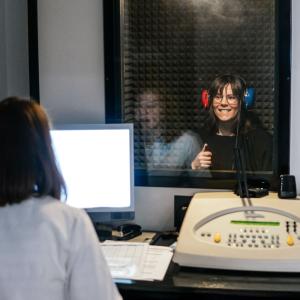
In July 2021, six weeks after the activation of her implant, Colleen Martin-O’Donnell sang with her group, The Rhapsody Players, at an outdoor summer concert: “I felt particularly triumphant that night after fearing I wouldn’t be able to bring the goods.”
In June 2020, Colleen Martin-O’Donnell, a lifelong singer and longtime employee of public television station WNET in New York City, woke up with a loud ringing in her right ear. It sounded like a smoke alarm. “Then I realized it was coming from inside my head,” recalls the 53-year-old Brooklyn resident. Doctors diagnosed severe vertigo, which resolved within a few weeks—but her sense of hearing in that ear failed to return.
Experts at NYU Langone Health’s Cochlear Implant Center conducted a series of tests to assess the extent of Martin-O’Donnell’s hearing loss. Ultimately, she and her clinical team agreed that cochlear implant surgery would be the only way to restore some hearing in her right ear, and David R. Friedmann, MD, associate professor in the Department of Otolaryngology—Head & Neck Surgery, performed the procedure.
Implanting and activating the device was only part of the process. For several months afterward, she worked intensively with the center’s audiologist and speech–language therapist, and with some rehabilitation apps on her cell phone, to learn to hear with the implant. She has since returned regularly for fine-tuning. “I feel much closer to the person I was before losing my hearing because of my cochlear implant,” she says.
Forty years after the center’s first implant, the technology continues to evolve, helping children and adults perceive sounds and understand speech. During that time, surgeons at the center have implanted more devices in patients than any other center in New York City—roughly 5,000 in all, including two implants in a 4-month-old infant who experienced hearing loss after a bout of meningitis.
“Cochlear implantation has become a viable option not only for those with profound deafness but also for people with severe hearing loss, those with single-sided deafness, and anyone struggling with their hearing aids,” says center co-director Sean O. McMenomey, MD. Dr. McMenomey is also a professor in the Departments of Otolaryngology—Head and Neck Surgery and Neurosurgery at NYU Grossman School of Medicine.
How Do Cochlear Implants Work?
Hearing involves an intricate interplay between the inner ear and the brain. Hair cells within the inner ear’s snail-shaped cochlea convert incoming sound vibrations into electrical impulses. Those impulses travel along the auditory nerve to the brain for translation into sound that we can understand. People who lack a well-formed cochlea, or who have damaged hair cells, may benefit from a cochlear implant.
The device consists of an internal portion, surgically placed within the inner ear, and an external portion worn behind the ear. The outer portion converts sound to electrical signals that the implant receives and sends to the brain. Put simply, it acts as a prosthetic inner ear.
Who Qualifies for a Cochlear Implant?
Many of the center’s youngest patients are born deaf. This kind of hearing loss may be due to an underdeveloped or misshapen cochlea or an auditory nerve that cannot carry the electrical signals, Dr. McMenomey explains.
Others, like Caitlin Parton, experience infections that attack their inner ear early in life. Parton was only 18 months old when she lost hearing in both ears due to a devastating infection called meningitis. In May 1987, surgeons placed an implant in her left ear, making her the center’s youngest patient at the time.
Parton, now a disability rights lawyer based near Boston, received a second cochlear implant in 2018, this time in her right ear. And for the first time in 30 years, she began hearing sounds in that ear too. “I still have hearing loss and I still don’t hear everything perfectly,” says Parton. “But it’s an incredible tool and it’s opened a lot of doors for me.”
Adults may be candidates if their speech discrimination score, based on their ability to identify various one-syllable words, is less than 60 percent with a hearing aid, says center co-director William H. Shapiro, AUD.
Some adults become candidates for cochlear implants due to age-related hearing loss, in which the cochlea’s hair cells begin to decline. Other adults can experience what’s called sudden idiopathic sensorineural hearing loss, in which they abruptly lose hearing in one ear for unknown reasons. “That’s our fastest-growing cohort of patients, and I think our cochlear implants in that group have been wildly successful,” says Dr. Shapiro, who is the Lester S. Miller, Jr. and Kathleen V. Miller Clinical Assistant Professor of Hearing Health in the Department of Otolaryngology—Head and Neck Surgery.
Four Decades of Progress
Since opening in 1984, the Cochlear Implant Center has been involved in testing every major innovation of the device, and its researchers continue to seek new enhancements to hearing loss treatment.
One 97-year-old, the center’s oldest patient so far, benefited from a unique surgical process developed at NYU Langone using a local sedative rather than general anesthesia. “The patient is awake but sedated, and recovery is much quicker than from general anesthesia,” explains Dr. Shapiro.
NYU Langone was one of the first centers in the country to perform a cochlear implant for single-sided deafness, an application that the U.S. Food and Drug Administration formally approved in 2019. And an experimental mapping process being developed at NYU Langone focuses on music perception for people with single-sided deafness.
Martin-O’Donnell is a beneficiary of that innovation. Periodic adjustments made to each electrode on her implant improve her ability to perceive sounds in the environment, like a bird tweet or a piano chord. She has resumed singing at her church and with a community group and marvels at her continued progress in locating and perceiving sounds.
“If I had said ‘I’m just going to try to hear with one ear,’ I think my life would be less rich,” she says.

